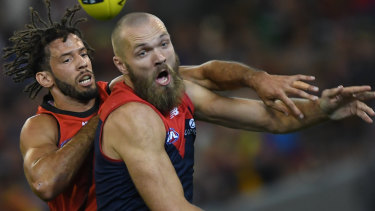Six-six-six … and the Demons’ devil of a dilemma in defence

The Melbourne-Essendon game might prove to be one of the most consequential of 2019, bearing in mind that the winner would be back near par, while the loser would be mired in the bunker or the water.
Melbourne supporters must console themselves with the example of the Swans of 2017, who lost their first six yet made the finals. Recovery is still possible.
In addition to the hefty stakes, the match contained an additional subplot: How it was played: fast, open, goals galore and with savage swings in momentum.

Zac attack: Zac Clarke and Max Gawn in the ruck.Credit:AAP
This was the type of game that (non-Demons supporting) viewers love, but coaches view with disdain, due to the defensive failings. Yet this was a necessary corrective after a fortnight of low scores, to lend credence to the new rules ushered in by the AFL.
Advertisement
Essendon and the Demons scored 10 goals from centre bounces. Clearly, six-six-six is the rule that will make the greatest difference to the shape of the game. Hitherto, the new rules had failed to boost goal production.
The architects of those reforms, the AFLs football boss Steve Hocking and his offsider David Rath, would have liked watching Anthony McDonald-Tipungwuti baulk and goal, Devon Smith and Orazio Fantasias blinding acceleration and the sense that neither team felt safe with the lead until the last two minutes.
The major take-outs, however, were for the clubs.
Essendon will be square at 2-2, without Joe Daniher and Cale Hooker, if they can overcome the Brisbane Lions at the MCG next weekend.
Has there been a Dons-Lions game so anticipated since the 2001 grand final?
Melbournes challenge will be to develop a team defence that offsets the personnel issues that have seen Port, Geelong and now the Bombers punch holes in their weakened back six. Their one-way midfield isnt making it easy for the backline, either.
Heres a few key findings and questions from a Friday night freighted with consequence.
1. ESSENDON SUCCEEDS WITH SPEED, NOT SIZE
The Dons dumped their two largest bodied midfielders in David Myers (191cm) and Kyle Langford (191cm), who left a midfield that is replete with quick smalls – Zach Merrett, David Zaharakis, Dylan Shiel, Darcy Parish and with Devon Smith available for bursts. None of that group is more than six foot.
Before the game, it was natural to wonder if the bigger, more physical Melbourne mids – especially Clayton Oliver and Angus Brayshaw – would have a decisive edge in the scrimmages and mass of bodies around the ball.
In the second quarter, Oliver and especially Brayshaw did seem to be on the verge of a midfield takeover, but for the majority of the match, the running power of the Bombers – whether swooping on loose balls or outside the contest – held sway over Melbournes strength and grunt. Smaller Essendon matched the larger Demons in contested ball.
Is it possible that the more agile and quick-footed midfielders will be advantaged by the extra space afforded them via six-six-six?
If so, Essendon would be better to do in their midfield what the Tigers did in their forward line in 2017-18.
If you dont have players of size of sufficient quality (Langford is still developing), then craft a game style around the players you have and their assets.
In all probability, this will mean the Dons are suited to a fast-paced, hectic game. While other clubs have developed a mark-kick, slow play – call it, ball control offence — this mightnt be Essendons go.
Essendon spent much of the pre-season seeking to implement an improved defensive system, imported with ex-Richmond defensive coordinator Ben Rutten. But it is unclear whether the Dons have the personnel to play along those lines; in John Worsfolds time, theyve performed well when taking the game on.
2. HOGANS ZEROES AND MAY DAY FOR THE DEFENCE
The trading of Jesse Hogan was contentious on many levels and is bound to be viewed through the prism of weekly performances by Hogan/Freo and Melbournes forward line. In a decision that was multi-faceted — cultural, salary cap-influenced, team balance — the Demons did so in the knowledge that it might hurt them in the short-term.
Melbourne again won the inside 50m count decisively (63 to 53), yet were beaten. Hogan, who booted 47 goals in 20 matches last year, has obviously been missed, particularly given Tom McDonalds physical struggles in pre-season and resultant dip in form.
This week however, the issue wasnt conversion of entries, it was their inability to defend. The Demons missed Steven May — the key defender whom they acquired via the Hogan deal — more than their former key forward. This was highlighted in the one-on-ones in which the likes of Sam Frost were out pointed by his opponents and in the awful lack of composure in defence.
3. PRE-SEASON SURGERIES AND THE RUNNING PROBLEM
MelbouRead More – Source
[contf] [contfnew] 
Australian Breaking News Headlines
[contfnewc] [contfnewc]




